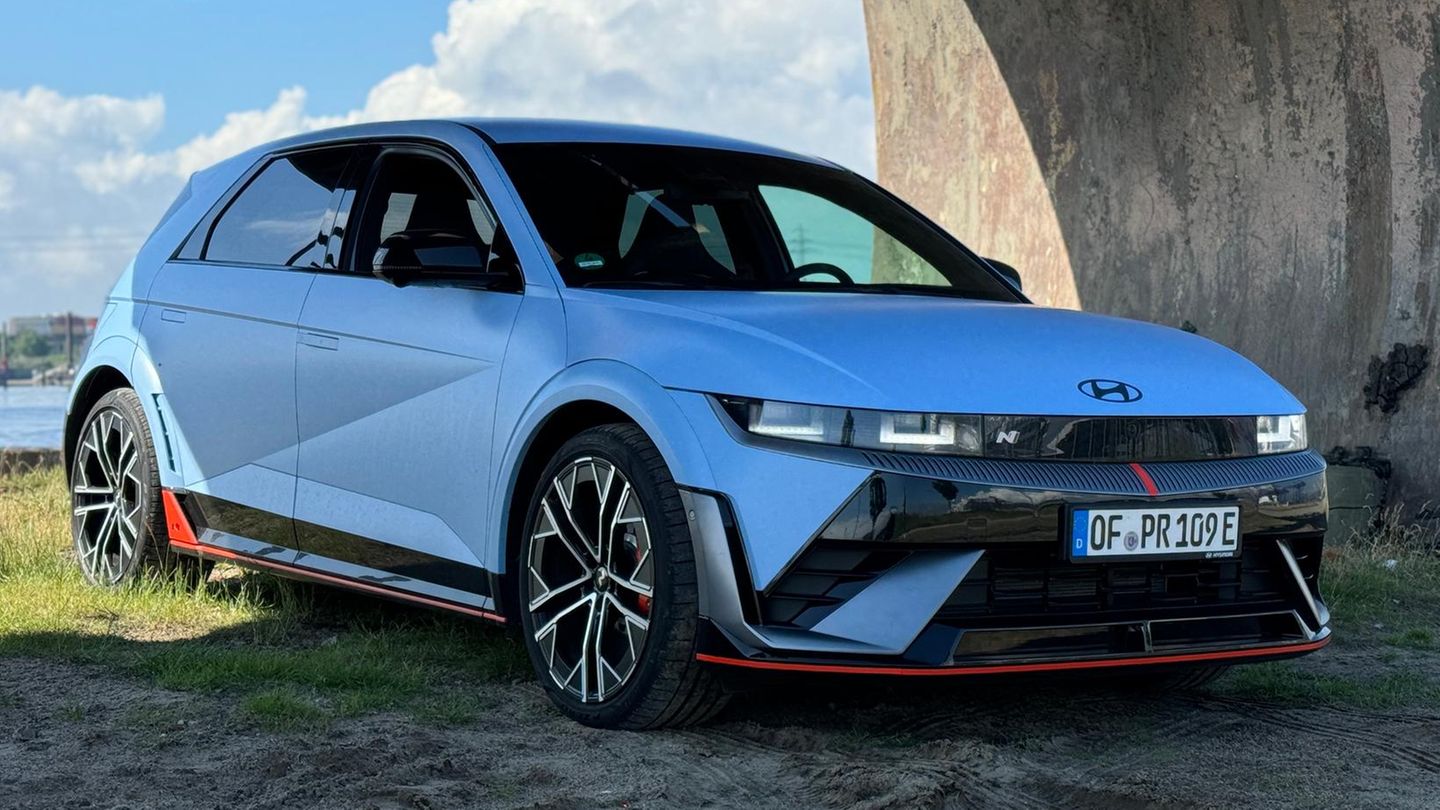Electric cars, whether from Hyundai or other manufacturers, have to put up with the accusation that they do not arouse emotions. It does not matter whether the cars have 150 or over 1000 horsepower. What many critics miss is the sound. The Koreans now want to rob the doubters of their arguments – and with the Ioniq 5 N they are bringing out a completely unique vehicle.
First of all, because this is very important: The Hyundai Ioniq 5 N, like the conventional Ioniq 5, can easily be used as a car for everyday use. The vehicle is spacious, comfortable and easy to drive. But that makes absolutely no sense.
To explain, we need to go into a bit of detail: Although the Hyundai Ioniq 5 N is very reminiscent of the model without the inconspicuous additional letter, the two cars only have the platform in common – the rest is fundamentally different. So much so that the car costs about twice as much as “without N”.
The Hyundai Ioniq 5 N is a “real N”, as Hyundai explains it. The N at Hyundai stands for what AMG is at Mercedes-Benz and M is at BMW – real sports cars that only share the basis with their average siblings and are otherwise radically different.
What makes the Hyundai Ioniq 5 N so exciting is the fact that it is an electric car. How can this be reconciled with the claim of being a real sports car? Let’s see.
Chip counter and wide slippers
Even the exterior of the Hyundai Ioniq 5 N reveals that something is slumbering inside it. In contrast to its comparatively staid siblings, the car boasts a mighty rear spoiler, trim strips, a lavish rear diffuser, even more trim strips, brake cooling and a fairly wide body kit. Added to this are the standard 21-inch rims and massive 400mm brake discs at the front as well as painted brake calipers.
Electric car
Hyundai Ioniq 5 N in pictures
Inside, the car is visually a little more reserved, but here and there you can find the N logo or other decorative elements that remind you of what you are actually driving. A glance at the steering wheel makes it clear: This is where things get serious – if you want them to.
The difference between N and non-N is most obvious when you look at the data. While the Ioniq 5 has to cope with a maximum of 325 hp, and in the base version only 170 hp, the 5N is bursting with power. 609 hp are permanently available to the car, and with a boost button it is 650 hp. This takes the car to 100 in 3.4 seconds and is enough for a top speed of just over 260. The maximum torque is 770 Newton meters – the launch control is like a small rocket launch.
The whole thing relies on a battery with 84 kilowatt hours. While the range in the test was around 380 kilometers due to an average consumption of 18 to 22 kilowatt hours per 100 kilometers – which is really not the best value in this price segment – the 5N was able to reduce the disappointment at the charging station somewhat.
Thanks to optimized charging performance, the car managed to go from 10 to 80 percent in exactly 19 minutes – sometimes at speeds of up to 270 kilowatts. That’s a top value and keeps charging breaks nice and short. But: On long stretches of highway, you are forced to take them; you can’t go from Düsseldorf to Hamburg in one go.
At home on the racetrack
The car’s strengths are not necessarily shown off when driving across the country. Circuits. That’s where it has to go, that’s what it’s been optimized for. Because only the Ioniq 5 N has factory-fitted sports seats, a completely new braking system with extra-strong recuperation, significantly increased body rigidity, drive axles from rally racing and countless “N technologies” that have been developed just for this car. The car combines all of this in – you guessed it – “N mode”. A single button that noticeably transforms the car.
The systems mentioned serve to ensure driving stability and speed on the one hand, but also to appeal to the child in every man or woman. More on that in a moment. In terms of performance, the Ioniq 5 N has nothing to hide from the competition. But these are not Smart #3 Brabus (tested here) or other Ioniq models, but Porsche Taycan (tested here), Tesla Model S Plaid, Lucid Air Sapphire or even Lamborghini Urus. You heard right: combustion engines are also the preferred prey of the electric car. And if you want, it can even imitate them.
Thanks to functions such as individually adjustable power distribution between the front and rear axles and launch control that can be adjusted to the respective grip level, the 5 N driver can keep his vehicle on track even in difficult situations. If you like, you can even get help with drifting and switch on the “N Drift Optimizer”, which prevents over-revving during rapid sideways driving. All very technical, but can be translated one-to-one into driving fun.
And if you need to come to a stop quickly, recuperation and braking work so well that the braking distance is reduced to a minimum. Practical: Thanks to the strong recuperation, the car ensures that the brakes do not overheat even during continuous use on the circuit, because they are less stressed than with combustion engines.
You need a diploma for the other settings in the N menu. There is actually nothing that the car doesn’t display. Once you’ve got the hang of it, you can find saved race tracks, for example, where the car can automatically record times if you’re driving there.
The nonexistent engine hums
Let’s get to the gimmicks that make the Hyundai Ioniq 5 N strangely unique. For example, you can choose from three engine sounds that are played to match the ride. They can also be heard from outside if desired. You can choose from spaceship, fighter jet and combustion engine. While the first two options are good, but not exceptional, the combustion engine sound is a real brain twister. Because if you let the sound run long enough, your head will eventually really think that you have an engine and a sports exhaust instead of the electric drive.
The impression is reinforced when you switch to manual shifting – again at the touch of a button. The Hyundai Ioniq 5 N then simulates an 8-speed dual-clutch transmission and behaves exactly like one. If you shift too high at low speed, the car won’t get going. If you rev too high, the limiter kicks in. For good shifting, you’re rewarded with exhaust sputtering and dull thuds.

An incredible amount of work must have gone into developing what is probably the most unnecessary technology in the world. An electric car that blares out of the exhaust and is manually shifted – what madness. But you have to experience it – at some point your mind will believe what the electric car is telling you. It’s madness.
It’s almost a shame that this function will probably never find its way into everyday life for any driver. Why should you throw away the advantages of a whisper-quiet ride without any gear shifting for a bit of burbling and humming? On the motorway or in the city, it simply doesn’t make sense – but when things get fast, it’s a welcome and really well-made bonus.
The consumption caused by “racing” should not go unmentioned. If you push the vehicle to its limits, the reserves seem to be depleted in five percent increments. Example: . That’s a total of about 42 kilometers. None of this is surprising, but it’s worth mentioning.
Conclusion: Hyundai Ioniq 5 N
How good you think the 5N is depends on what you see it as. If you take it as a Taycan or Model S Plaid competitor, you get an equally good vehicle for a fraction of the money. Even if 75,000 euros is still a lot of money, the price is far from the cost of comparable sports cars. In terms of performance, it easily beats cars – yes, even combustion engines – that cost many times as much.
If you need it primarily as an everyday car, it’s going to be tight. The normal Ioniq 5 can do most of the same things – just slower and with a smaller battery. The looks of the car must be important to you if you rarely have the opportunity to drive the 5N. It would still be a good car, just completely oversized.
Source: Stern
I’m a recent graduate of the University of Missouri with a degree in journalism. I started working as a news reporter for 24 Hours World about two years ago, and I’ve been writing articles ever since. My main focus is automotive news, but I’ve also written about politics, lifestyle, and entertainment.




